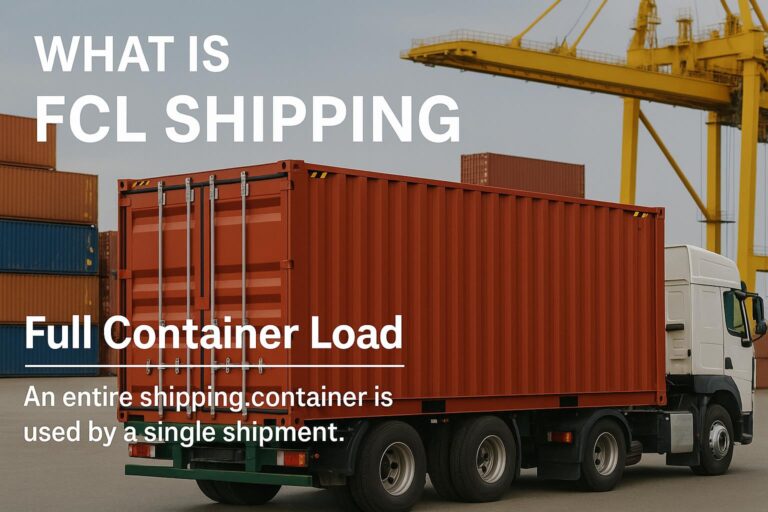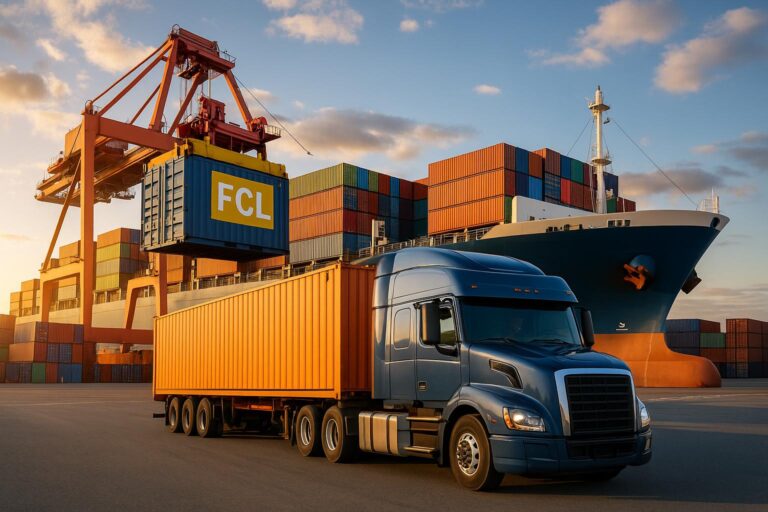What is FCL Shipping? In today’s global trade landscape, FCL shipping—short for Full Container Load shipping—is one of the most reliable and cost-effective ways to transport large quantities of goods across oceans and borders. But what exactly does FCL shipping mean? How does it differ from other shipping methods like LCL (Less than Container Load)? And how can you ensure you’re making the most of this shipping method to minimize transportation costs? Let’s explore all these questions and more in this comprehensive guide.

Definition of FCL Shipping
FCL shipping stands for Full Container Load shipping, meaning that an entire shipping container is occupied by goods from a single shipper. The container is sealed at the point of origin and only opened once it reaches its final destination. This shipping method reduces handling, minimizes risks of damage or loss, and often provides significant cost savings for large volume shipments.
How Does FCL Shipping Work?
Here’s a step-by-step overview of the FCL shipment process:
Container Booking
The shipper or an experienced freight forwarder books the appropriate container size (like 20-foot or 40-foot standard containers) with a shipping line.
Cargo Loading
Goods are loaded into the container at the shipper’s warehouse or a third-party facility. Proper packing and securing of cargo ensure that the shipment arrives safely at its destination port.
Container Sealing
Once the container is loaded, it’s sealed and remains untouched until it arrives at the consignee’s location. This sealed single container minimizes the risk of damage during transit.
Transport to Port
The sealed container is transported via truck, rail, or barge to the port of departure, ready for ocean freight or, in special cases, air freight.
Ocean Freight / Air Freight
Most FCL containers travel via sea freight, carried by large cargo ships. For some urgent or specialized shipments, air freight can be used for smaller, high-value goods.
Arrival and Customs Clearance
At the destination port, the container is unloaded and processed through customs clearance. FCL shipments typically have a smoother process because the container holds goods from only one shipper.
Final Delivery
After clearing customs, the FCL container is delivered to the consignee’s facility or warehouse, where it’s unsealed and unloaded.
Key Advantages of FCL Shipping
Lower Risk of Damage
Since the entire container is dedicated to a single shipper’s goods, there’s less handling and therefore less chance of damage or contamination from other shipments.
Faster Delivery Timelines
FCL shipments skip the consolidation and deconsolidation steps required for LCL shipments, resulting in faster overall delivery timelines.
Cost Effective for Large Volume Shipments
Although the total cost for FCL may be higher, it’s usually cheaper per unit for businesses shipping large quantities—making it ideal for bulk cargo or high-value goods.
Simplified Customs Clearance
Because FCL involves only one shipper, the customs clearance process is often faster and less complex compared to LCL shipping.
FCL vs. LCL: Which is Best?
Criteria | FCL Shipping | LCL Shipping |
|---|---|---|
Container Use | One full container for one shipper | Container space shared with other shippers |
Risk of Damage | Minimal handling, lower risk | More handling, higher risk of damage |
Cost Savings | Better cost savings for large shipments | More economical for smaller shipments |
Customs Clearance | Easier, faster, less documentation | Can be slower due to multiple shippers’ docs |
Transit Time | Generally faster | Slightly longer due to consolidation |
Best Suited For | Large volume, high-value, or bulky cargo | Smaller, less urgent shipments |
Choosing the Right Container for FCL Shipping
Understanding the container size and type can help optimize FCL shipping costs:
20-Foot Standard Container: Ideal for dense cargo like machinery or raw materials.
40-Foot Standard Container: Great for larger loads of general cargo.
40-Foot High Cube Container: Offers extra height for bulky goods.
Reefer Containers: Temperature-controlled for perishable goods.
Open Top / Flat Rack Containers: For oversized or out-of-gauge cargo.
Choosing the right container ensures efficient space use and helps minimize costs.
You may be interested:
Cost of 20ft & 40ft Containers from China to Brazil
20ft & 40ft Container Shipping Costs from China to France
Cost of Shipping 20ft & 40ft Containers from China to UAE
20ft & 40ft Container Shipping Costs from China to Saudi Arabia
20ft & 40ft Container Shipping Costs from China to Germany
Shipping Costs for 20ft & 40ft Containers from China to Russia

Common FCL Shipping Terms
To navigate the FCL shipment process confidently, it’s helpful to understand common shipping terms:
TEU (Twenty Foot Equivalent Unit): Standard unit of measurement for shipping containers.
Demurrage Charges: Fees incurred when containers stay too long at the port.
Detention Fees: Fees for holding onto the container beyond the agreed timeframe.
Freight Forwarder: A professional intermediary who arranges FCL container load shipments and handles documentation and logistics.
Working with an experienced freight forwarder ensures your FCL shipments avoid unnecessary delays and unexpected demurrage and detention fees.
Factors That Impact FCL Shipping Costs
Several key factors affect FCL pricing:
- Container Load Size: A 40ft container typically costs more than a 20ft container.
- Shipping Route: Longer distances and congested routes can increase transportation costs.
- Seasonal Demand: Prices rise during peak seasons, such as pre-holiday surges.
- Cargo Type: Oversized or hazardous cargo can require special handling, impacting the final cost.
- Customs Clearance Fees: Depending on the destination, customs processes and fees can vary.
- Congestion Surcharge: Fees that carriers charge during peak congestion periods.
Understanding these factors can help you budget effectively and negotiate better rates for your next FCL shipment.
Tips to Minimize FCL Shipping Costs
- Consolidate Cargo: If your shipment is close to a full container, consider consolidating to a single FCL container rather than splitting into LCL.
- Book Early: Early booking often secures better rates and availability.
- Use an Experienced Freight Forwarder: They can offer guidance on the best shipping method (FCL or LCL) and navigate customs smoothly.
- Monitor Demurrage and Detention Fees: Be aware of these fees and ensure timely container returns to avoid unnecessary charges.
When to Choose FCL Shipping?
FCL shipping is typically best when:
- Your cargo volume can fill or nearly fill an entire container.
- Your goods are high-value or fragile, and you want minimal handling.
- You need faster transit times and simplified customs processes.
- You’re shipping to high-traffic trade lanes with established container load shipments.
Frequently Asked Questions (FAQs)
Q1: What is FCL shipping and how does it work?
A: FCL shipping means using an entire shipping container for one shipper’s goods. It’s sealed at origin, transported by ocean freight, and only opened at the destination.
Q2: Is FCL shipping cost-effective?
A: Yes, for large volume shipments. While the total container cost is higher, the per-unit cost is lower than LCL.
Q3: How do demurrage and detention fees work in FCL shipping?
A: Demurrage charges apply if the container stays at the port too long. Detention fees occur if you don’t return the empty container in time. Proper planning avoids these costs.
Q4: Can I ship smaller shipments with FCL?
A: It’s possible, but unless you have enough volume to fill the container, LCL shipping might be more economical.
Q5: What’s the role of a freight forwarder in FCL shipping?
A: A freight forwarder manages the entire process—booking, documentation, customs clearance—ensuring your FCL container arrives safely and efficiently.
Conclusion: Is FCL Shipping Right for You?
If your business requires shipping large quantities of goods, FCL shipping offers significant cost savings, reduced handling, and smoother customs processes. Working with an experienced freight forwarder helps ensure your shipments move efficiently, avoiding costly detention fees or delays.
Ready to ship your next FCL container or compare FCL vs. LCL options? Contact our team at Tonlexing for a customized quote and expert guidance on your international shipments!

